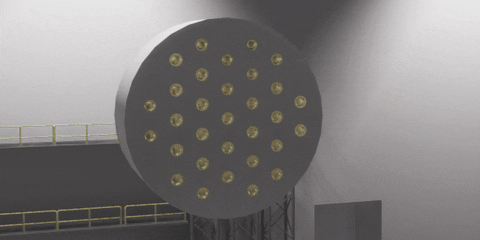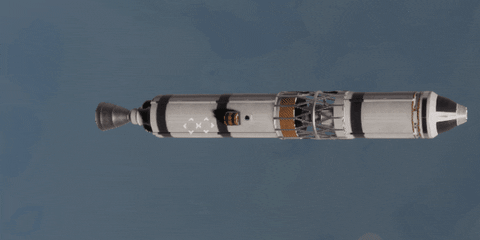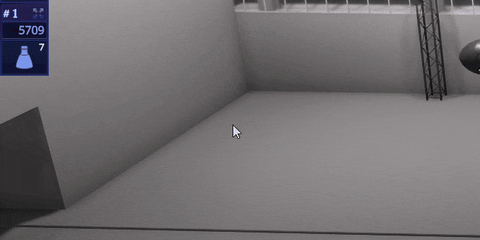Work In Progress: Planes
A quick update here about a new feature that is coming in the next v0.17 version of Rocket Science. So, this is actually happening. At the beginning of the development I thought planes are too complicated to make, and even placed researching this topic post v1.0 release into my roadmap. But the more I worked on the game and the more my skills improved, the more I began to realize that it was not only possible, but doable in the time frame of one update cycle.
 Planes have been at the back of my mind since the first rocket take-off in the game
Planes have been at the back of my mind since the first rocket take-off in the game
One issue that I had to address before even starting research was the compatibility of the socket system with wings. The point is that planes, unlike rockets, need to be properly balanced so that the center of lift is behind the center of mass. I had no suitable sockets for that and the distance between each slot was 0.7m which is too far for proper balancing. So I've added a new type of socket. It is a line of slots with any number of them and 2x reduced distance between each one. And as I mentioned in the previous update, such sockets would look like swiss cheese. This was another reason to implement sockets hiding everywhere except assembly shop. Also I had to make them smaller, because with reduced distance the become like a mess.
After that, one week of heavy research and five weeks of development I finally put everything together.
 Note, that all the gifs are work in progress, anything can be changed
Note, that all the gifs are work in progress, anything can be changed
The amount of new things that need to be added into the game to support planes is the biggest so far. Just take a look at this list of features.
- wings and lift and drag force calculations for them;
- control surfaces such ailerons and flaps;
- autocorrection system for lift forces;
- wheels, including steering and braking;
- new engine type: turbopropeller;
- new fuel type: kerosene;
- mirror symmetry for spacecraft assembly;
- center of lift and thrust calculations;
- new launch facility - runway.
And many more. The most complicated feature from this list was reinventing the wheel by the way, because Unity's builtin wheels do not work in the spherical gravity. But this is a story for another time. As are many otherstories about this development cycle, but I hope to be able to tell one or two in the actual update (now I simply have no time for that).
 The basic functioning wheel took me one week to made...
The basic functioning wheel took me one week to made...
Almost all of these things are 75-80% complete and I want to release the update someday in November. I didn't fully solve plane balancing yet and I need to finish tons of smaller features too. And, if I have some time left, I will try to add more than one plane set of rocket parts and add tutorials for all that.
 You can see there a new type of symmetry — mirror
You can see there a new type of symmetry — mirror
Thank you for your attention and see you in the v0.17.0 update!
 Plane flight feels so different from rockets, it is like a new dimension for the game
Plane flight feels so different from rockets, it is like a new dimension for the game
 Planes have been at the back of my mind since the first rocket take-off in the game
Planes have been at the back of my mind since the first rocket take-off in the gameOne issue that I had to address before even starting research was the compatibility of the socket system with wings. The point is that planes, unlike rockets, need to be properly balanced so that the center of lift is behind the center of mass. I had no suitable sockets for that and the distance between each slot was 0.7m which is too far for proper balancing. So I've added a new type of socket. It is a line of slots with any number of them and 2x reduced distance between each one. And as I mentioned in the previous update, such sockets would look like swiss cheese. This was another reason to implement sockets hiding everywhere except assembly shop. Also I had to make them smaller, because with reduced distance the become like a mess.
After that, one week of heavy research and five weeks of development I finally put everything together.
 Note, that all the gifs are work in progress, anything can be changed
Note, that all the gifs are work in progress, anything can be changedThe amount of new things that need to be added into the game to support planes is the biggest so far. Just take a look at this list of features.
- wings and lift and drag force calculations for them;
- control surfaces such ailerons and flaps;
- autocorrection system for lift forces;
- wheels, including steering and braking;
- new engine type: turbopropeller;
- new fuel type: kerosene;
- mirror symmetry for spacecraft assembly;
- center of lift and thrust calculations;
- new launch facility - runway.
And many more. The most complicated feature from this list was reinventing the wheel by the way, because Unity's builtin wheels do not work in the spherical gravity. But this is a story for another time. As are many otherstories about this development cycle, but I hope to be able to tell one or two in the actual update (now I simply have no time for that).
 The basic functioning wheel took me one week to made...
The basic functioning wheel took me one week to made...Almost all of these things are 75-80% complete and I want to release the update someday in November. I didn't fully solve plane balancing yet and I need to finish tons of smaller features too. And, if I have some time left, I will try to add more than one plane set of rocket parts and add tutorials for all that.
 You can see there a new type of symmetry — mirror
You can see there a new type of symmetry — mirrorThank you for your attention and see you in the v0.17.0 update!
 Plane flight feels so different from rockets, it is like a new dimension for the game
Plane flight feels so different from rockets, it is like a new dimension for the game
 Typical game view just after engine migration
Typical game view just after engine migration I am thinking about even bigger attachment for the largest fuel tanks radius in the game, but those will come later
I am thinking about even bigger attachment for the largest fuel tanks radius in the game, but those will come later The view you are used to and it will remain in the rocket editing mode
The view you are used to and it will remain in the rocket editing mode How it would look elsewhere
How it would look elsewhere Here I immediately found a bug, that the effect of explosion in space stays fixed in one point instead of moving on the same orbit.
Here I immediately found a bug, that the effect of explosion in space stays fixed in one point instead of moving on the same orbit.


 Finally what you see on the map will match to what you get during the flight
Finally what you see on the map will match to what you get during the flight Planet's surface received much more details
Planet's surface received much more details Sometimes it produces slightly weird results, but this is a procedural approach, what can you do, eh
Sometimes it produces slightly weird results, but this is a procedural approach, what can you do, eh Moon was already good, but now it's simply great
Moon was already good, but now it's simply great


 I know, you are waiting a new parachute too, but it is crazy complicated process to make it. But it is coming sooner or later
I know, you are waiting a new parachute too, but it is crazy complicated process to make it. But it is coming sooner or later This is how it looks like in the game engine
This is how it looks like in the game engine An example of color map for part of the world. Generated in 2020
An example of color map for part of the world. Generated in 2020 The first colors of Earth's palette
The first colors of Earth's palette Frequency map for the first color from the palette
Frequency map for the first color from the palette Temperature frequency curves for each color in the palette
Temperature frequency curves for each color in the palette This colors is actually in the game
This colors is actually in the game This is how it would look like
This is how it would look like Before
Before After. It could be improved even more, but for this stage of the development it is enough
After. It could be improved even more, but for this stage of the development it is enough